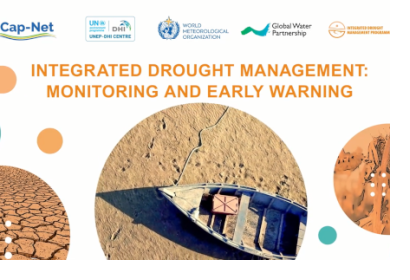
UNEP-DHI
World Meteorological Organisation
Global Water Partnership
IDMP
Volta Flood and Drought Management
Droughts have deep, widespread, and often underestimated impacts on societies, ecosystems and economies. While drought is a recurring and natural climatic phenomenon, climate change is increasing temperatures and evaporation as well as disrupting rainfall patterns, increasing the frequency, severity and duration of droughts in many regions.
A proactive, integrated approach to drought management is essential. Three pillars need to be considered to ensure a successful drought policy and implementation:
- monitoring and early warning,
- vulnerability and impact assessment, and
- preparedness, mitigation and response.
About this Course
This course presents the definitions, life cycle and common impacts of drought, introduces the three pillars of integrated drought management, before focusing in more detail on monitoring and early warning. Access to data is key to drought monitoring and early warning processes. Indicators and indices are used to describe drought conditions and provide the basis for conducting drought assessments.
By learning how to select indicators and indices that are relevant to their regional context, the course is a practical introduction to the available tools and products that can be used for drought monitoring and forecasting, as well as impact assessment. The course has been developed by the Integrated Drought Management Programme (IDMP) in collaboration with several IDMP.
Course Objectives
- Explain the drought phenomenon and how climate change affects it
- Understand the “three pillars approach” of proactive integrated drought management
- Demonstrate how integrated drought management is related to international processes, including the Sustainable Development Goals (SDGs), Paris Agreement, Sendai Framework for Disaster Risk Reduction 2015-2030, and UNCCD.
- Identify which components and parameters of the water cycle impact drought monitoring
- Assess current drought risk using historical hazard and impact data
- Outline the elements of a drought early warning system
- Assess, select and interpret regionally relevant drought monitoring indices and triggers
- Analyse relevant indices with a focus on agricultural impacts
- Create a drought intensity map from data and indicators using the tools presented in this course
The course is open to participants representing various stakeholder groups working with drought management who are interested in taking the course and completing all modules. This includes:
- Meteorological and hydrological experts from climate departments, climate service providers, environmental and disaster risk reduction agencies, agriculture experts and policy-oriented professionals
- Stakeholders and professionals forming part of water management, civil society, river basin or international organizations; development programmes and members of UN organizations; and representatives of the private sector
- Sustainable Development Goals focal points and facilitators within national governments
- Decision-makers, policymakers, resource managers and high-level professionals and managers active in governmental bodies
- Capacity developers active in the fields of Drought Management, Integrated Water Resources Management, Climate Action, among others.
Gender balance is very important for all course partners; we especially encourage women to participate in this course.
